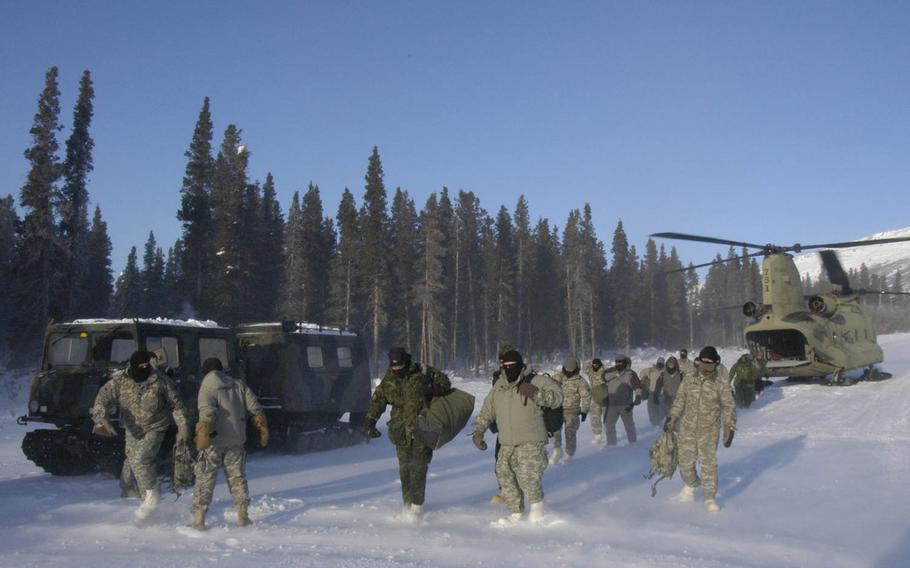
U.S. soldiers, Marines and foreign military personnel arrive at Black Rapids Training Site, Alaska earlier this month. (Seth Robson/Stars and Stripes)
ANCHORAGE, Alaska — The Army could remove the bulk of its forces in Alaska under cost-saving plans that will cut active-duty ranks by tens of thousands of troops, the military said.
Department of the Army officials are in Alaska this week talking to people about the looming force cuts — mandated under the Budget Control Act of 2011, commonly known as sequestration. The act required that the Army reduce its troop strength from a high of 570,000 in 2010 to 450,000 by the end of fiscal year 2017. If sequestration-level funding continues in fiscal year 2016, the Army will have to reduce its active duty force to 420,000.
U.S. Army Alaska spokesman Lt. Col. Alan Brown said two Alaskan Army posts - Fort Wainwright and Joint Base Elmendorf-Richardson - are among 30 installations being considered for force reductions.
Worst-case scenarios would see the loss of the bulk of 13,000 active duty soldiers stationed in Alaska, including 5,300 personnel at Fort Richardson and 5,800 personnel at Fort Wainwright, Brown said.
“That would be both our combat brigades,” he said. Alaska is home to the 25th Infantry Division’s 1st Stryker Brigade Combat Team at Wainwright and the 4th Brigade Combat Team (Airborne) at Richardson.
Richardson is already slated to lose about 200 personnel when the 2nd Engineer Brigade inactivates in May, although most of the brigade’s soldiers will remain in Alaska with other units, Brown said.
Officials deciding where to cut forces will look at military considerations as well as on- and off-base infrastructure, community investment, schools and education, medical services, family and veteran support and quality of life, he said.
Basing troops in Alaska has many advantages, Brown said.
Alaskan forces are part of the Pacific Pivot strategy, which involves efforts to boost military engagement in a region that’s home to bulk of the world’s people live and many of America’s most important trade partners.
“We have partnerships with all these Pacific countries,” Brown said. “It is going to take us less time to get to a contingency in Asia than it would from the Lower 48.”
Last year paratroopers from Alaska showed what they could do during the Cobra Gold exercise in Thailand.
After a 16-hour flight from Elmendorf on a C-17 transport they parachuted into Thailand, trained for three days and then returned home, he said.
Last week a platoon of Alaska-based paratroopers jumped onto the Japanese island of Hokkaido with Japan Self Defense Force soldiers and this summer 600 soldiers from Alaska will participate in the Talisman Saber exercise in Australia, Brown said.
Anchorage businessman Justin Green, whose demolition company has worked regularly on bases in Alaska, said the military is a vital part of the community.
“If these bases close down that’s less money in the local economy,” he said.
Decisions on which Army units and organizations will be selected for possible reductions have not yet been made. The analysis of environmental and socioeconomic impacts as well as community feedback will be considered by decision makers, according to U.S. Army Alaska.
robson.seth@stripes.comTwitter: @SethRobson1